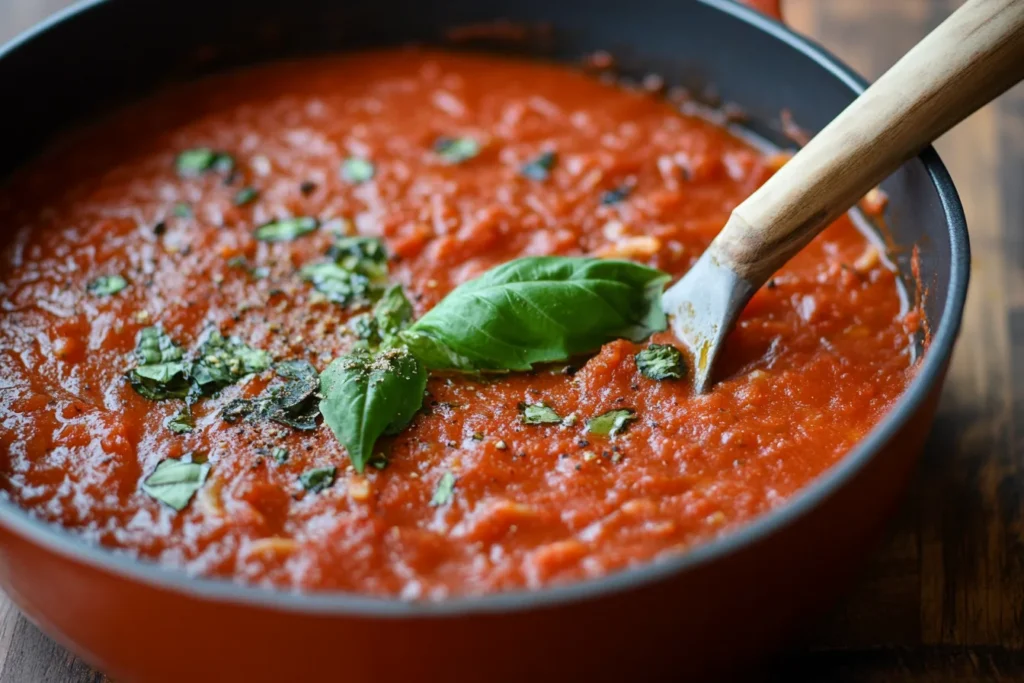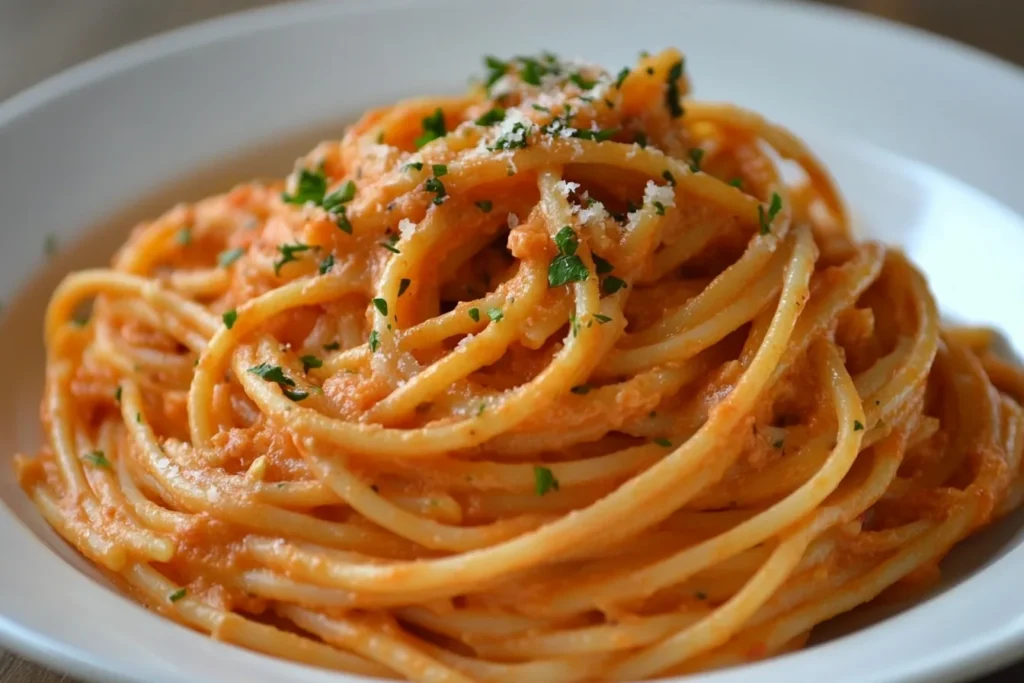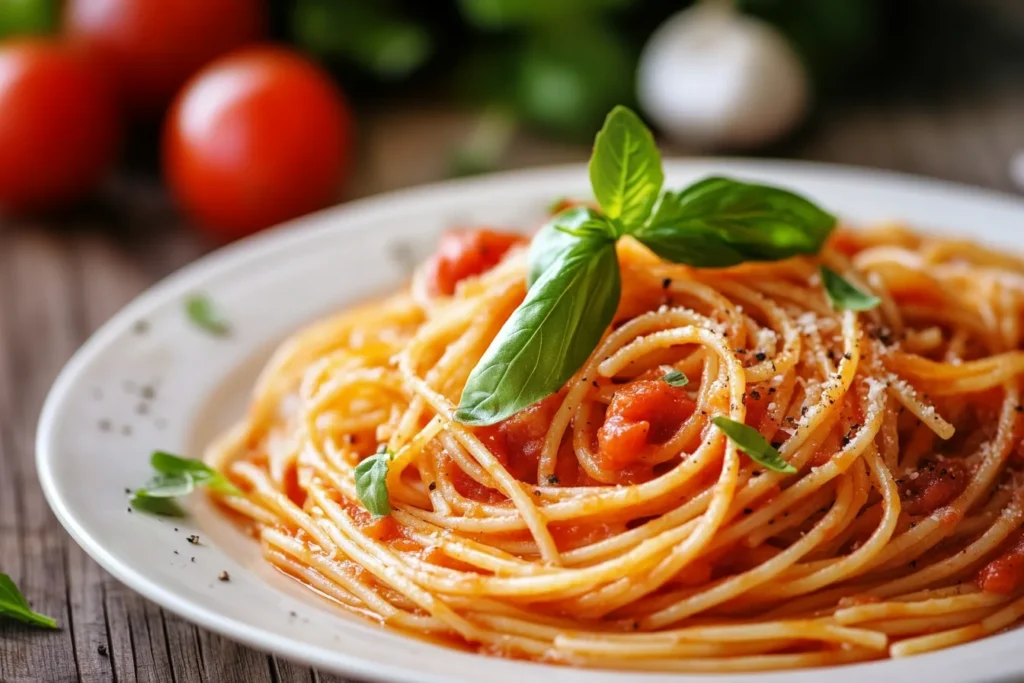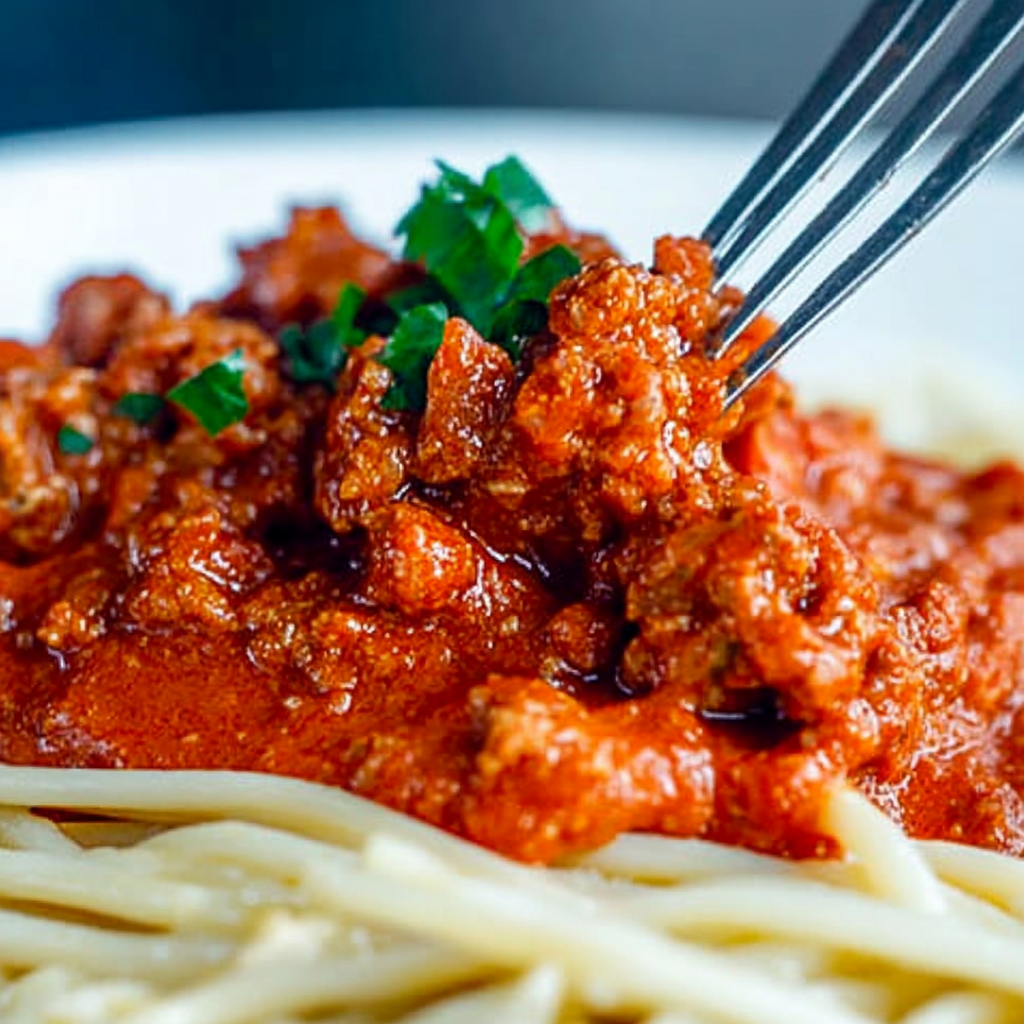How to Make a Creamy Vegetarian Spaghetti Sauce Without Cream
A Healthier, Dairy-Free Twist on Classic Pasta
When you think of creamy spaghetti sauce, heavy cream and cheese often come to mind. But what if you could create a creamy vegetarian spaghetti sauce without cream that’s just as rich and satisfying? Whether you’re lactose-intolerant, vegan, or simply looking for a healthier alternative, this guide will show you how to make indulgent sauces using dairy-free, plant-based ingredients.
From nut-based creams to blended vegetables, you’ll discover how to achieve a smooth, silky texture without a drop of cream.
Why Go Cream-Free?
Choosing a cream-free sauce offers numerous benefits:
- Healthier options: Traditional cream-based sauces are high in saturated fat and calories. Dairy-free alternatives often provide fewer calories and healthier fats.
- Dietary inclusivity: Cream-free recipes cater to vegans, lactose-intolerant individuals, and those with dairy allergies.
- Nutritional boost: Substitutes like vegetables, nuts, and legumes add essential fiber, protein, and vitamins.
For those seeking to reduce dairy consumption, cream-free sauces allow you to enjoy the same luxurious texture guilt-free.
If you’re looking for healthy pasta inspiration, you’ll find excellent creamy alternatives here.

The Secret to a Creamy Texture Without Cream
Creaminess isn’t solely reserved for dairy. It’s about using the right substitutes that mimic cream’s silky texture. Below, discover some of the best options!
Blended Vegetables for Creaminess
Vegetables like cauliflower, butternut squash, and potatoes create an amazing creamy base when cooked and blended:
- Cauliflower: Steamed or roasted, cauliflower blends into a neutral-flavored cream. Perfect for sauces like Alfredo.
- Butternut Squash: Roasted squash adds a sweet, earthy note while keeping the sauce smooth and luxurious.
- Potatoes: Starchy and thick, potatoes blend into a silky, hearty sauce.
To enhance flavor, add ingredients like roasted garlic, vegetable broth, or nutritional yeast for a cheesy note.
Nut-Based Cream Alternatives
Nuts are rich in healthy fats and blend into smooth, creamy bases:
- Cashews: Soaked cashews create a velvety, neutral cream that pairs beautifully with garlic and herbs.
- Almonds: Blanched almonds work similarly to cashews but with a slightly nutty flavor.
- Coconut Milk: While coconut milk has a mild coconut flavor, it’s excellent for recipes needing creaminess and sweet undertones.
For step-by-step cashew cream inspiration, explore Minimalist Baker’s cashew cream guide.
Silken Tofu for Protein and Smooth Texture
Silken tofu is a game-changer for dairy-free sauces.
- It’s high in protein and creates a smooth texture without overwhelming flavors.
- Blend silken tofu with tomato sauce, garlic, and basil for a creamy marinara.
This option is particularly great for vegan diets and those looking to boost protein intake in their meals.
Plant-Based Milk Options
Plant-based milk offers excellent low-fat alternatives for cream:
- Oat Milk: Naturally creamy and mild, oat milk blends seamlessly into sauces.
- Soy Milk: With a neutral flavor and thicker consistency, soy milk is perfect for Alfredo-style sauces.
- Unsweetened Almond Milk: Lighter than other options, it works well when combined with a roux or thickener.
Combine plant-based milk with garlic, herbs, and nutritional yeast for a light yet creamy sauce.
Blending Legumes for Thickness
Legumes like chickpeas, cannellini beans, and lentils can be blended into a rich, creamy sauce.
- Chickpeas: High in protein and fiber, chickpeas create a velvety sauce that’s nutritious and satisfying.
- Cannellini Beans: These white beans are creamy when pureed and add a mild, buttery flavor.
- Lentils: Red lentils, when overcooked and blended, make a silky, thick base.
This method not only boosts creaminess but adds a protein punch, making it a healthy meal option.
Avocado for a Unique Creamy Base
Avocado isn’t just for guacamole! Its rich, buttery texture makes it a standout base for creamy sauces:
- Combine avocado with basil, garlic, and lemon juice for a creamy pesto twist.
- Its healthy fats add creaminess while maintaining nutritional benefits.
Plus, avocado-based sauces are perfect for quick, no-cook recipes.
Yogurt Alternatives for Tangy Creaminess
Coconut or soy yogurt can replace cream while adding a slight tanginess.
- Use unsweetened coconut yogurt for a smooth, dairy-free Alfredo.
- Soy yogurt works well for creamy tomato sauces or vegetable purees.
Combine yogurt with garlic, vegetable broth, and nutritional yeast for depth and tang.
Nutritional Yeast for a Cheesy Flavor
Nutritional yeast is a dairy-free powerhouse for adding:
- A cheesy, umami flavor to sauces.
- Essential vitamins, particularly B12 for vegan diets.
Sprinkle nutritional yeast into blended vegetables, tofu, or nut-based sauces for a rich, cheesy kick.
Olive Oil and Flour Roux
For a classic thickening technique without cream, use a simple roux:
- Heat olive oil in a pan.
- Whisk in flour to create a thick paste.
- Slowly add plant-based milk or vegetable broth while whisking.
This method is perfect for achieving a silky texture in Alfredo or white sauces.
These creamy substitutes offer a variety of options, ensuring your spaghetti sauces are rich, delicious, and dairy-free.
Part 2: Recipes for Creamy Vegetarian Sauces
Top Creamy Vegetarian Spaghetti Sauce Recipes
Creating a creamy, dairy-free spaghetti sauce doesn’t mean sacrificing flavor or texture.
Below are some of the best recipes that are rich, satisfying, and completely vegetarian.

Creamy Cashew Alfredo Sauce
Cashews are one of the most versatile ingredients for creating a smooth, protein-rich sauce.
Ingredients:
- 1 cup raw cashews (soaked for 4 hours or boiled for 15 minutes)
- 1 cup unsweetened plant-based milk (like oat or almond)
- 2 cloves garlic, minced
- 2 tablespoons nutritional yeast
- 1 tablespoon olive oil
- 1 teaspoon lemon juice
- Salt and black pepper to taste
Step-by-Step Instructions:
- Soak and soften the cashews: Soak them in water for at least 4 hours or boil for 15 minutes to soften.
- Blend ingredients: In a high-speed blender, combine the soaked cashews, plant-based milk, garlic, nutritional yeast, olive oil, lemon juice, salt, and pepper. Blend until smooth.
- Heat the sauce: Pour the mixture into a saucepan and gently heat over medium heat, whisking constantly. Add a splash of water or milk to adjust thickness.
- Serve: Toss with cooked spaghetti and garnish with fresh parsley or vegan Parmesan.
This creamy Alfredo is velvety, cheesy, and perfect for a cozy pasta night.
Cauliflower Cream Sauce with Garlic
Cauliflower is a low-calorie, nutrient-rich substitute for cream and delivers a luscious sauce.
Ingredients:
- 1 medium head of cauliflower, cut into florets
- 4 cloves garlic, roasted or sautéed
- 1 ½ cups vegetable broth
- 1 tablespoon olive oil
- 1 teaspoon nutritional yeast
- Salt and black pepper to taste
Step-by-Step Instructions:
- Cook the cauliflower: Steam or boil the cauliflower florets until tender (about 10 minutes).
- Sauté the garlic: Roast garlic cloves in olive oil for a deeper, caramelized flavor.
- Blend: Combine the cooked cauliflower, roasted garlic, and vegetable broth in a blender. Add olive oil, nutritional yeast, salt, and pepper. Blend until smooth and creamy.
- Adjust consistency: Add more broth if needed. Heat gently on the stove.
- Serve: Toss the sauce with hot spaghetti and top with fresh herbs.
This recipe is light, flavorful, and packed with hidden vegetables.
Silken Tofu Creamy Marinara
Silken tofu adds a protein boost and silky texture to classic tomato sauce.
Ingredients:
- 1 ½ cups silken tofu
- 2 cups marinara sauce (homemade or store-bought)
- 1 teaspoon olive oil
- ½ teaspoon garlic powder
- Salt and black pepper to taste
Step-by-Step Instructions:
- Blend the tofu: In a blender, combine silken tofu with garlic powder and a pinch of salt. Blend until completely smooth.
- Combine with marinara: Heat marinara sauce in a pan over medium heat. Slowly stir in the blended tofu, whisking until fully incorporated.
- Adjust seasonings: Add more salt, pepper, or Italian herbs to taste.
- Serve: Toss with spaghetti for a creamy, tangy marinara twist.
This protein-packed recipe is perfect for busy weeknights.
Butternut Squash and Coconut Milk Sauce
Sweet, earthy butternut squash pairs beautifully with creamy coconut milk in this sauce.
Ingredients:
- 2 cups butternut squash, peeled and diced
- 1 cup coconut milk (full-fat)
- 2 cloves garlic, minced
- 1 tablespoon olive oil
- 1 teaspoon sage (dried or fresh)
- Salt and pepper to taste
Step-by-Step Instructions
- Blend the ingredients: In a blender or food processor, combine the avocado, fresh basil, garlic, olive oil, lemon juice, and nutritional yeast (if using). Blend until the mixture is completely smooth and creamy.
- Adjust the consistency: If the sauce is too thick, gradually add water, one tablespoon at a time. Blend after each addition until you reach the perfect consistency—silky, spreadable, and just thick enough to coat the spaghetti without being runny.
- Serve: Toss the creamy avocado sauce with hot spaghetti, ensuring every noodle is evenly coated. To elevate the dish, garnish with juicy cherry tomatoes, crunchy pine nuts, or a sprinkle of vegan Parmesan for extra flavor and texture.
This vibrant, fresh, and nutrient-packed sauce is a perfect choice for light summer pasta dishes, offering a burst of flavor and a creamy finish in every bite.
Avocado Basil Pesto Sauce
Avocado’s creamy texture and nutritious fats elevate classic pesto to new levels.
Ingredients:
- 1 ripe avocado, peeled and pitted
- 1 cup fresh basil leaves
- 2 tablespoons olive oil
- 2 cloves garlic
- 1 tablespoon lemon juice
- Salt and pepper to taste
- Optional: 1 tablespoon nutritional yeast
Step-by-Step Instructions:
- Blend the ingredients: In a blender or food processor, combine the avocado, fresh basil, garlic, olive oil, lemon juice, and nutritional yeast (if using). Blend the mixture until it becomes smooth and creamy.
- Adjust the consistency: If the sauce feels too thick, add water one tablespoon at a time, blending in between, until you achieve the desired texture. The sauce should be silky and spreadable without being runny.
- Serve: Toss the creamy avocado sauce with hot spaghetti, ensuring the noodles are evenly coated. Finish the dish by garnishing with cherry tomatoes, pine nuts, or a sprinkle of vegan Parmesan for extra flavor and texture.
This vibrant, fresh, and nutrient-packed sauce is the perfect choice for light summer pasta dishes, delivering a burst of flavor in every bite.
Cannellini Bean and Garlic Sauce
Creamy white beans make an excellent base for a quick, protein-rich sauce.
Ingredients:
- 1 ½ cups canned cannellini beans (drained and rinsed)
- 2 cloves garlic, sautéed
- 1 cup vegetable broth
- 1 tablespoon olive oil
- ½ teaspoon thyme
- Salt and black pepper to taste
Step-by-Step Instructions:
- Sauté the garlic: In a pan, heat olive oil and sauté garlic until fragrant.
- Blend ingredients: In a blender, combine the beans, vegetable broth, garlic, olive oil, and thyme. Blend until smooth.
- Heat the sauce: Pour into a saucepan and gently warm over medium heat. Adjust consistency with additional broth.
- Serve: Toss with spaghetti and top with cracked black pepper and fresh thyme.
This sauce is hearty, simple, and packed with fiber and protein.
These recipes clearly demonstrate that a creamy vegetarian spaghetti sauce doesn’t need dairy to be both indulgent and flavorful. By using versatile ingredients like nut-based creams, blended vegetables, and protein-rich alternatives, there’s truly a recipe to suit every palate and preference.
Part 3: Tips, Variations, and Final Thoughts
Tips for Making the Perfect Creamy Sauce Without Cream
Achieving the smooth, velvety texture of traditional cream sauces—without relying on dairy—requires mastering a few essential techniques. Below are expert tips to take your cream-free spaghetti sauces to the next level:
- Start with the right base: Choose ingredients like cauliflower, cashews, or silken tofu, as they provide a naturally creamy texture when blended. These bases are adaptable and take on flavors effortlessly.
- Invest in a high-quality blender: A high-speed blender ensures your sauces are ultra-smooth and free of lumps, particularly for nut-based or vegetable purées.
- Layer your flavors thoughtfully: Balance creamy textures with bold elements like roasted garlic, herbs, and spices. A touch of acidity from lemon juice or vinegar can lift the sauce beautifully.
- Thin it with pasta water: Reserve a cup of pasta water to help your sauce cling perfectly to the spaghetti. The starchy water also ensures a smooth consistency.
- Don’t be afraid to experiment: Adjust the thickness, flavor, or creaminess by combining bases like nut creams with vegetable broths or adding small amounts of olive oil for richness.
With these tips, you can create restaurant-quality sauces that are not only dairy-free but also delicious and nutrient-dense.
How to Balance Flavor in Cream-Free Sauces
Creating rich and flavorful dairy-free sauces requires a thoughtful approach to layering bold ingredients. The goal is to mimic the depth and richness of traditional cream-based sauces while maintaining a balanced flavor. Here are key strategies to achieve this:
- Use garlic and onions: Both roasted garlic and caramelized onions are flavor powerhouses. They provide depth, natural sweetness, and a subtle richness that elevates any sauce. Roasting garlic, in particular, softens its sharpness and infuses the sauce with a warm, savory aroma that feels indulgent yet balanced.
- Incorporate herbs and spices: Fresh herbs like basil, sage, or parsley brighten the sauce, providing contrast to the creaminess. For added complexity, include warming spices like nutmeg, smoky paprika, or a pinch of red pepper flakes for a gentle kick. These elements layer the flavor beautifully and keep the sauce dynamic.
- Add acidic elements: Acidity is a game-changer for balancing richness. A squeeze of lemon juice or a splash of vinegar cuts through heaviness, lifting the sauce and giving it a lighter, more vibrant profile. This trick is especially effective with nut-based or vegetable-heavy sauces.
- Include nutritional yeast: Nutritional yeast is your secret weapon for adding a cheesy, umami-packed flavor. It deepens the taste without dairy, perfectly complementing creamy bases like cashews, tofu, or blended vegetables.
Pro Tip: Always taste as you go! Adjust the seasoning gradually by adding small amounts of salt, fresh herbs, or acidic ingredients. This ensures the flavors remain harmonious and the sauce achieves that perfect balance between creamy and bold.
By thoughtfully layering these ingredients, you can craft dairy-free sauces that are rich, complex, and every bit as satisfying as their cream-based counterparts.
A quick tip: Add warm liquid (like broth or plant milk) when blending for easier processing.
How to Balance Flavor in Cream-Free Sauces
Creating rich and flavorful dairy-free sauces requires thoughtful use of bold ingredients to mimic the depth and richness of traditional cream-based recipes. Here are some key tips to achieve perfect balance:
- Use garlic and onions: Roasted garlic and caramelized onions are flavor powerhouses. They add depth, sweetness, and a touch of richness that elevates any sauce. Roasting garlic, in particular, softens its sharpness while infusing a warm, savory aroma.
- Incorporate herbs and spices: Fresh herbs like basil, sage, or parsley brighten sauces and add a fresh contrast to creamy textures. To enhance complexity, include spices such as nutmeg for warmth, paprika for smokiness, or red pepper flakes for a subtle kick.
- Add acidic elements: A squeeze of lemon juice or a splash of vinegar works wonders to cut through any heaviness. Acidity lifts the sauce, creating a lighter, more balanced flavor profile.
- Include nutritional yeast: For a cheesy, umami-packed boost, nutritional yeast is your go-to ingredient. It adds depth without the need for dairy and complements creamy bases like cashews, tofu, or vegetables.
Pro Tip: Taste as you go! Adjust your seasonings gradually by adding small amounts of salt, herbs, or acidity until the flavors are perfectly balanced. This step ensures your sauce is harmonious and full of flavor.
By incorporating these techniques, you can craft bold, flavorful sauces that are as satisfying as their dairy-based counterparts.ngs gradually for a perfectly balanced sauce.

Adding Vegetables for Nutritional Boost
Creamy sauces are an excellent vehicle for hidden vegetables, adding vitamins and fiber without compromising flavor:
- Spinach: Add fresh spinach to cauliflower or cashew sauces for a nutritional boost. It blends easily and turns the sauce vibrantly green.
- Broccoli: Steam broccoli florets and blend them into sauces for added texture and nutrition.
- Roasted Red Peppers: Roasted peppers add a smoky-sweet note and creamy consistency when blended.
You can even sneak in carrots or zucchini for extra veggies while maintaining the sauce’s silky texture.
Enhancing Creaminess Without Overpowering Flavor
Achieving the perfect level of creaminess in a dish while keeping the flavors balanced requires some simple strategies:
- Use neutral-flavored bases: Ingredients like cauliflower or silken tofu are ideal because they have a mild, adaptable flavor. This allows them to take on the seasonings and herbs in your dish without dominating the overall taste.
- Lighten nut-based creams: While nut creams like cashew or almond cream are deliciously rich, they can sometimes feel heavy. To balance this, combine them with vegetable broth to create a lighter yet equally creamy consistency.
- Enhance with olive oil or plant-based butter: Adding a small amount of olive oil or vegan butter helps achieve a silky texture while avoiding excess fat. Just a tablespoon can make a significant difference in creaminess without overpowering the dish.
- Experiment with quantities: Every sauce has its unique balance, so start with smaller amounts of creamy ingredients and gradually adjust. This ensures you reach the perfect consistency and flavor that suits your taste.
By using these techniques, you can create sauces that are rich and creamy while keeping the flavors harmonious and light.
Customizing Creamy Sauces for Dietary Needs
Whether you’re vegan, gluten-free, or watching your calories, you can customize cream-free sauces to fit any diet.
Low-Fat Options for Light Creamy Sauces
For lighter alternatives:
- Use vegetable purees like cauliflower or squash instead of nut-based creams.
- Replace plant milk with vegetable broth to cut calories while maintaining creaminess.
- Blend in low-fat yogurt alternatives, such as coconut or soy yogurt, for a light and tangy flavor.
These options ensure you can indulge without straying from a low-fat diet.
Protein-Packed Additions to Boost Nutrition
Adding protein-rich ingredients to your cream-free sauces ensures your meals are both satisfying and nutritious.
- Blend silken tofu or cannellini beans: Both options create a smooth, creamy base while adding a solid boost of protein. Silken tofu is perfect for light marinara blends, while cannellini beans provide a buttery texture for heartier sauces.
- Nutritional yeast: This powerhouse ingredient not only adds plant-based protein but also delivers a cheesy, umami flavor to sauces. Sprinkle it in during blending for a nutritious upgrade.
- Cooked lentils or chickpeas: For a more textured sauce, mix in lentils or chickpeas. They provide an extra dose of protein and fiber while enhancing the overall heartiness of your dish.
By combining protein-packed ingredients with nutrient-rich vegetables, you create sauces that are both balanced and filling.
Pairing Creamy Vegetarian Sauces with Spaghetti
The choice of pasta can elevate the texture and flavor of your creamy vegetarian sauces. Here’s how to choose the right type:
- Traditional spaghetti: This classic pasta works beautifully with smooth and rich sauces like cashew Alfredo or silken tofu marinara. The noodles perfectly coat with every creamy bite.
- Whole wheat spaghetti: If you want to add extra fiber and an earthy flavor to your meal, whole wheat spaghetti is ideal. It pairs especially well with nut-based sauces or roasted squash blends.
- Gluten-free pasta: For those with dietary restrictions, options like chickpea or brown rice spaghetti are excellent. Their subtle flavors complement thicker, bean-based sauces without overpowering them.
Pro Tip: Always reserve some pasta water before draining your spaghetti. Adding a splash of it to your sauce helps thin the consistency while allowing it to cling perfectly to the noodles.
Serving Suggestions for a Complete Meal
Transform your creamy vegetarian spaghetti dish into a full, satisfying meal with these simple yet delicious additions:
- Salads: Pair your creamy pasta with a light, tangy salad for contrast. A mix of arugula and lemon vinaigrette provides freshness that complements the richness of the sauce.
- Garlic Bread: Nothing pairs better with pasta than a slice of crispy, golden garlic bread. For a dairy-free twist, use vegan butter and a sprinkle of garlic powder to keep it completely plant-based.
- Vegan Cheese: Finish your dish with a sprinkle of vegan Parmesan or mozzarella. These alternatives add a cheesy flavor without the dairy.
- Roasted Vegetables: Add a side of roasted mushrooms, zucchini, or asparagus for a boost of nutrients and texture. Roasting vegetables enhances their natural sweetness, making them a perfect match for creamy sauces.
By combining these sides, you create a complete and balanced meal that’s both hearty and nutritious—perfect for family dinners or special occasions.
Final Thoughts on Cream-Free Creamy Spaghetti Sauces
Making a creamy vegetarian spaghetti sauce without cream is easier than you think. With ingredients like blended vegetables, nuts, silken tofu, and legumes, you can create sauces that are:
- Rich and velvety
- Healthy and nutritious
- Diet-friendly and satisfying
Whether you’re crafting a cashew Alfredo, a cauliflower garlic sauce, or a butternut squash coconut sauce, these recipes are as versatile as they are delicious.
By experimenting with techniques, flavors, and ingredients, you can enjoy a creamy spaghetti dish that’s healthy, indulgent, and 100% dairy-free.
Frequently Asked Questions (FAQs)
1. What’s the best substitute for cream in Alfredo sauce?
The best alternative is soaked cashews blended with plant-based milk. This combination achieves a smooth, velvety texture similar to traditional cream sauces.
2. How do I make a creamy sauce without a blender?
If you don’t have a blender, you can use a food processor or immersion blender. For softer ingredients like roasted vegetables or avocado, mashing by hand works well for a chunkier texture.
3. Is coconut milk too sweet for savory pasta dishes?
While coconut milk has a mild sweetness, full-fat coconut milk balances beautifully in savory dishes, especially when combined with garlic, spices, or herbs like basil and thyme.
4. Can I freeze dairy-free creamy sauces?
Yes, dairy-free sauces like cashew cream or vegetable purées freeze well. Thaw them in the fridge and reheat with a splash of water or broth to restore their creamy consistency.
5. How do I fix a sauce that’s too thick?
Simply add a bit of reserved pasta water, vegetable broth, or plant-based milk. Stir slowly and adjust until the sauce reaches your desired consistency.
6. What’s the healthiest creamy sauce alternative?
Blended cauliflower or white beans are the healthiest options. They’re low in fat, high in fiber, and packed with nutrients, making them excellent cream substitutes.
7. Can nutritional yeast make a sauce taste cheesy?
Absolutely! Nutritional yeast is a dairy-free favorite, adding a cheesy, umami flavor that enhances creamy sauces without the need for actual cheese.
8. What pasta pairs best with creamy vegetarian sauces?
- Spaghetti: Perfect for smooth sauces like cashew Alfredo.
- Whole wheat pasta: Complements nut-based or squash-based sauces with its earthy flavor.
- Gluten-free pasta: Options like chickpea or brown rice pasta pair well with thicker sauces, such as those made from beans.
9. How do I make the sauce extra flavorful?
Enhance flavor by adding:
- Roasted garlic or caramelized onions for depth
- Fresh herbs like basil or sage for brightness
- A splash of lemon juice or vinegar to balance richness
10. How long do these sauces last in the fridge?
Dairy-free creamy sauces can be stored for 3 to 5 days in an airtight container in the fridge. If you need longer storage, freeze the sauce in portions for convenience.
Related article : What are the best vegetables to include in vegetarian spaghetti?

